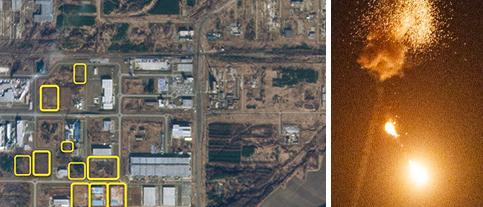Published 2024-10-10 23.54
unsaveSave
ⓘ The summary is made with the support of AI tools from OpenAI and quality assured by Aftonbladet. Read our AI policy here.
Show more
chevron-down
The remote factory has grown enormously since the Russian invasion.
Here they build the drones that will create terror in the air over Ukraine.
Now Putin’s secret moves to secure the deadly production are revealed.
The factory is located in Tartarstan, approximately 100 miles east of Moscow.
Here they assemble the Iranian attack drones that are one of Putin’s weapons in the war against Ukraine.
AP
The pictures show increased activity
Satellite images of the area from before and after the invasion show that the factory complex is growing considerably.
From being an area for civilian businesses, it is military activity that has taken over, writes AP, which has reviewed the mysterious production.
Initially, the drones of the Shahed-136 type were sent assembled to Russia for further use in the war. Now they are assembled on site in the factory in Tartarstan and probably another factory in Russia.
The goal is to be able to produce 6,000 a year from 2025. A goal that Russia already seems to be achieving, according to warnings from the American Institute for Science and International Security, AP writes.
expand-left
full screen A Russian drone on its way to its target in Ukraine. Photo: AP
Dangerous job
In Tartarstan alone, it is now up to 4,500, according to data in AP’s review.
But finding enough workers to do the dangerous and poorly paid work has proven difficult.
The workers work with corrosive chemicals without protective equipment and live in fear of Ukrainian attacks. Earlier this year, the drone factory was attacked by a Ukrainian drone and twelve people were injured.
In a program aimed at several African countries, around 200 young women aged 18-22 have been recruited by promising “a free plane ticket, money and an adventure in Europe”, AP writes.
expand-left
full screenUkrainian air defense shoots down a Russian drone. Photo: AP
“Be a trap”
But instead of being allowed to study Russian and work in industries such as hotels and restaurants, the women have been accommodated in dormitories and driven by bus to the drone factory.
– It was a trap, says one of the women AP spoke to.
Only when she arrived did she realize what it was all about.
– I regret and curse the day I started making this.
According to leaked internal documents from the factory, the workforce has grown rapidly. Last year, around 900 people worked there. Next year, they plan to be up to over 2,600.
A downed drone in a research lab in Kyiv.
1 / 3Photo: AP
Got holes on my cheeks
Many of them are foreign women mainly from Africa, but also Asia and South America.
According to AP, Russia has also tried to recruit workers from orphanages in Uganda.
The women share dormitories and kitchens that are “monitored around the clock” by cameras.
An African woman AP spoke to said the recruits are taught how to assemble the drones and then paint them with a “yogurt-like” substance.
She says the chemicals make her face feel like a thousand needles and that “little holes” have formed on her cheeks.
– Many of the girls are suffering, she says.
The recruited African women reportedly earn around SEK 5,000 a month.
But when the costs of the plane ticket, accommodation, medical care and Russian lessons are deducted from the salary, not much remains.
expand-left
full screenWreckage from a downed drone near the city of Kupjansk. Photo: AP
Deficient quality
According to human rights organizations that AP has been in contact with, they have no insight into what is going on in the factory, but that it is in line with how Russia usually acts.
The drones that the women build are said to be of no further quality.
Of the 2,000 Iranian attack drones that Russia has sent against Ukraine since the end of July, 95 percent have not hit any clearly designated target, AP writes.
Instead, they have ended up in Ukrainian rivers and fields or dumped in Russia and Belarus.
The low hit rate may, according to experts, be partly due to improved Ukrainian air defenses – but also due to poorly trained personnel who simply assemble the drones in a substandard manner.
– I don’t really know how to build a drone, says a young woman who left her job in an African country attracted by the Russian offer.
expand-left
full screen The massive factory complex is located in Tatarstan 100 miles east of Moscow. Photo: AP
